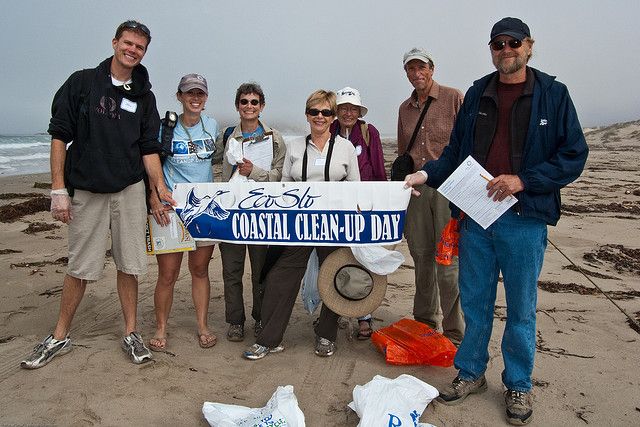Did the Middle Ages end and the Renaissance begin because of advances in art, music, and culture? Or did the epochal transition occur because of improved sanitation and hygiene?
Maybe the above questions are absurd, or at least not nearly complex enough. If winners write history, then perhaps the Middle Ages just got stuck with centuries’ worth of accumulated negatives. Meanwhile, the Renaissance comes out looking as smart as a DaVinci invention and as enlightened as a Poussin painting.
Yes, no, maybe – and let’s see what Google Scholar has to say? And, more immediately, what does any of this have to do with this week’s City/Culture column?
Last Saturday, September 25, the 25th annual International Coastal Cleanup took place. Sponsored by the non-profit Ocean Conservancy, this on-the-shore and in-the-sea trash pick-up day has become a wildly popular distributed event taking place in 45 U.S. states as well as107 other countries.
Famously started by one person – the now-global event in 2009 involved just shy of 500,000 volunteer participants who collectively brought in and catalogued some 7.4 million pounds of trash, according to an Ocean Conservancy tally.
The event has spread to inland spots too – in the Echo Park neighborhood of Los Angeles, volunteers scoured the area in and around the small Echo Park Lake.
The City / Culture column is, in part, an ongoing discussion about the work done in part by creative individuals or collectives – work that might otherwise be considered to be under the purview of government.
This column has been quick to credit the likes of museum-known artists and best-selling authors, but too slow to salute graphic designers and web designers who likewise play important roles.
The Ocean Conservancy’s website, for example, has a series of easy-to-read infographics and .pdf downloads that attest to the massive amount of garbage bespoiling favored sand-and-saltwater spots.
The web stats aren’t intended to be comprehensive – the non-profit relies on volunteers to come out and clean, and different regions are over-, or under-represented. (In short – this ain’t the U.S. Census.) In California last year, that meant 82,365 people bagged nearly 1.4 million pounds of trash. In Montana – bordering no oceans – four people showed up and hauled out 25 pounds.
Still, the resulting clean-up stats are fascinating. Want to know how many cigar tips were cleaned by members of the Nebraska crew? Check the site’s “Debris Report.” Same for shotgun shells and wadding found by the Mississippi crew. Batteries by Texans. And condoms by Virginians, which apparently, is really for lovers.
Worldwide, Conservancy volunteers collected 10.2 million items of marine detritus. Cigarettes and cigarette filters were said to make up 21% by item of all the trash collected. Plastic bags came in second, at 11%. Food wrappers and containers; caps and lids; and plastic beverage bottles each accounted for 9% of the mess.
With plastic bags and plastic beverage bottles already adding up to 20% of the total trash haul, that got City / Culture reminiscing about Dr. Marcus Eriksen and Anna Cummins. They are the folks behind the Algalita Marine Research Foundation’s JUNKraft.
That remarkable seaworthy vessel carried Eriksen and a colleague, Joel Paschal, from Los Angeles to Hawaii three summers ago. JUNKraft was constructed out of 15,000 plastic bottles. The highly successful purpose of the voyage was to gain public attention about how much plastic trash sits in the sea – and inside fish, and in our own bodies.
(Disclosure: The City / Culture columnist booked Eriksen and Cummins for a Farmlab Public Salon.)
While at sea, Eriksen noted not just how much plastic waste he’d encounter, but also how few fish – at least compared to the descriptions he’d read in books describing historic nautical journeys.
Last year, the New Yorker magazine published an extensive profile of David de Rothschild and his own efforts toward building a plastic boat. Far better reading than the story is Eriksen’s reply to the magazine, which is here.
A short version of the above is that Eriksen strenuously objected to what he perceived to be the magazine’s dismissal of his work as merely an ‘adventure.’ On the contrary, the JUNKraft website offers up a menu tab labeled, “Solutions.” The text on the resulting page begins like this:
“It makes no sense that we invent a material designed to last forever, then make products from it that are designed to be thrown away. There are two solutions that are working around the world to end the Age of Disposable Plastic, and recycling isn’t top on the list. First, bring your own reusables. Second, support legislation to curb consumption of single-use plastics.”
Eriksen and his colleagues’ success, like that of the group’s mentor, Dr. Charles Moore, and like that of the Ocean Conservancy, come in great part because of visionary thinking combined with innovative implementation and outreach.
From blogging to making television appearances (Martha Stewart!) , to first-rate graphic and web design, projects such as the International Coastal Clean-up and JUNKraft are conceived and executed by creative groups and individuals, not, say, a municipal agency.
Sometimes, of course, lines blur. Take Mierle Laderman Ukeles, who since 1977 has been the official New York City Department of Sanitation artist-in-residence.
Ukeles isn’t paid by the city for her work – which in general, she’s termed Maintenance Art – but yet in one early project, she spent a year shaking hands with and meeting 8,500 or so members of the Department, and thanking them for their work.
When any of us encounters a Coastal Clean-up Day volunteer, or a JUNKraft crew or support team member, let’s do the same.
Read past City / Culture columns here. Email the columnist at lathinktank [at] gmail [dot] org.



_920_518_600_350_80_s_c1.jpg)












